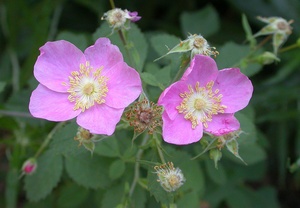The Chumash people and their ancestors have historically occupied this particular stretch of the California coastline, now identified as Isla Vista , for thousands of years. They learnt about their unique environment, developing ways to improve their standard of living. This included utilising the local fauna for medicinal purposes. The rare biological richness and diversity of the region is something that facilitated such medicinal practices. The arrival of the Europeans severely impacted the ecosystem and altered it to what we now see today as they brought in non-native species such as the Eucalyptus. Despite this, many native plants can still be found around the UCSB campus and Isla Vista area. Such plants are rarely used for medicinal purposes today, especially as many are considered rare, and are even state, if not federally protected.
Standard health care and western institutions do not teach practitioners to honor or heal the spirit despite its positive outcomes. Western medicine focuses on healing localized problems instead of the entire mechanism or human body, spirit included. Like many native communities healing begins with the spirit first and then the body. Through prayer, aromatherapy, laughter and other techniques Chumash healers have treated patients for over 13,000 years. This sacred art is still practiced in California. (Adams & Garcia)
Over the years Isla Vista’s college culture has gained a party reputation (link to halloween news articles). This party reputation is synonymous with drinking alcohol and students who drink heavily often experience the painful aftermath of a hangover. Overuse of pain medication can have lasting affects on the liver while natural remedies have minimal to no side effects. This post will illustrate which plants, used by the Chumash, can still be found around our campus and within the Isla Vista area and what medicinal purpose they serve for modern application. By integrating Chumash medicinal practices we will apply this knowledge by creating an all natural herbal tonic.
A Selection of Native Plants Found Around the Isla Vista Area and their Medicinal Uses:
Swamp Root/ Yerba Mansa
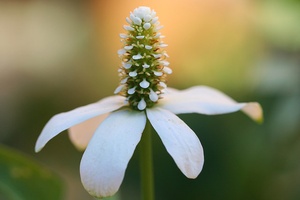 Yerba Mansa by Lars Hammar
Yerba Mansa by Lars Hammar
Latin: Anemopsis Californica
Barbareño (Chumash language of the region): ‘onchochi
This important medicinal plant was used both internally and externally. The root is best picked in spring and dried before use but can be used fresh at anytime. As a tea it is valued as a healing wash for cuts, ulcerated sores, venereal disease, cough and a blood purifier. Due to its high medicinal value, it has been intentionally spread in regions such as the Channel Islands and can be found locally in the Manzanita Village restoration area and surrounding the lagoon.
Coastal Sagebrush/ California Sagebrush
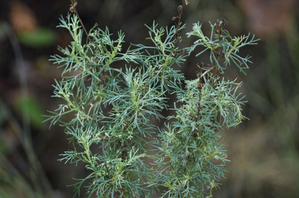 California Sagebrush by BJ Stacey
California Sagebrush by BJ Stacey
Latin: Artemisia californica
Barbareño: we’wey
Found at the West depression near Campus point (Map)
This plant has several medicinal uses including headache, cough and possibly poison-oak remedies. You can tie the leaves to your forehead or rub the leaves between your hands while in water and then wet your head and hair.
White Sage
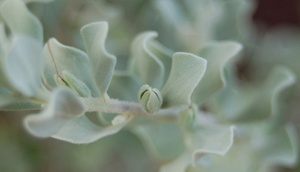 White Sage by PaPa PDL
White Sage by PaPa PDL
Latin: Salvia apiana
Barbareño: khapshikh
Found in the coastal sage scrub ecosystems within the area, such as around Sands beach and near campus point around the lagoon. Much like the California Sagebrush, the leaves of the fresh and strong-scented White Sage can be placed on one's forehead as an effective treatment for headaches. However, unlike the California Sagebrush, White Sage is used to induce vomiting by pounding leaves, adding them to cold water, and drinking the concoction.
Mugwort
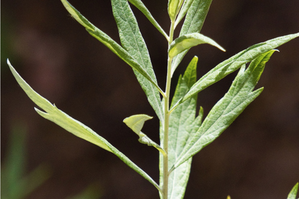 Mugwort by BJ Stacey
Mugwort by BJ Stacey
Latin: Artemisia douglasiana
Barbareño: Molush
In recent decades Mugwort has been used for headache and toothache relief when the leaves are applied as a poultice. As a tea, the leaves are boiled and drunk to reduce symptoms of asthma while this same tonic in a larger quantity can serve as a bath remedy for poison oak. Found in the biofiltration marsh in front of Manzanita Village and in the Coastal Sage Scrub areas on Lagoon Island. (Map)
Californian Rose
Latin: Rosa californica
Barbareño: washtiq’oliq’ol (pronounced wotteekwoneekwone)
The Californian Rose can be found in the Oak woodlands in the area, on the Lagoon Island and by Ellwood Mesa (Map). When mashed in water the California rose petals help soothe pain for babies while teething. The Chumash also used the dried and powdered rose petals on babies like a talcum powder to soothe chafing and rashes. Adults also use the rose in the form of a tea, often mixed with other herbs to relieve blockages in the stomach. The pleasant scent is also used in aromatherapy to relieve anxiety.
Quail Bush
 Atriplex lentiformis breweri ©2008. Photo by Ken Gilliland
Atriplex lentiformis breweri ©2008. Photo by Ken Gilliland
Latin: Atriplex lentiformis
Barbareño: ‘i’laq’
This shrub is common along the Santa Barbara and Ventura coastal bluffs. It grows in very alkaline and saline conditions, hence it’s name origin. The native americans burned the Atriplex and used the ashes as lye in order to make soap out of it.
Spotted Spurge
 UC Statewide IPM Project ©2001 Regents, University of California
UC Statewide IPM Project ©2001 Regents, University of California
Latin: Chamaesyce maculata
Barbareño: No known Chumashan names
This herb was first introduced to Santa Barbara from the eastern side of the U.S. and reportedly used to commonly treat fevers and warts. The plant is also stated to have been used by local Native Americans to treat spider/snake bites by being steeped in wine in either its dry or fresh form them applied to the bites.
Thick leaved yerba santa
 Copyright 1992-2014 Las Pilitas Nursery
Copyright 1992-2014 Las Pilitas Nursery
Latin: Eriodictyon crassifolium
Barbareño: wis^h ap'
This was called “yerba santa” (meaning “holy herb”) by both Spanish missionaries and the Chumash in recognition of its all of its medicinal applications. The Chumash would simmer the leaves in water and drank the tea in order to soothe ailments including: colds, chest pain, cough, asthma, throat/lung aches and fevers. They also used the plant externally by rubbing the hot baths of yerba santa (sometimes infused with alcohol or whiskey) for: foot pain, chest pains, and other related ailments. Chumash descendants continue to use this herb to make a genral tonic to heal respiratory ailments as well as general aches and pains.
Curly Dock
 Curly Dock by Shinner & Mahler
Curly Dock by Shinner & Mahler
Latin: Rumex crispus
Barbareño: tsuxat', stuxat'
This plant was very useful to the Chumash considering they used all of its parts. The leaves would be cooked and eaten raw, the peeled stem would be eaten raw, the seeds would be pounded into a raw dough which would then be baked and eaten, and the roots could be boiled to make a medicinal tea in order to treat an upset stomach. (Robert H. Mohlenbrock. USDA SCS. 1989. Midwest wetland flora: Field office illustrated guide to plant species. Midwest National Technical Center, Lincoln. Provided by USDA NRCS Wetland Science Institute (WSI))
California Goldenrod
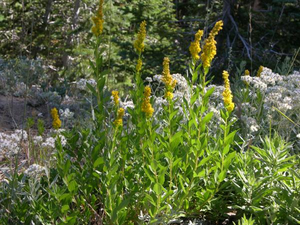 Solidago_californica_05.JPG by Ken Gilliland
Solidago_californica_05.JPG by Ken Gilliland
Latin: Solidago californica
Barbareño: stu' 'ima'
The Chumash names given to this species of plants refer to its leaves’ resemblance to the ears of a jackrabbit. Most Chumash used it as a tea to be taken for coughs and colds however they also used it as a wash or powder for sores and wounds. The plant is also later reportedly used as a general tonic to relieve indigestion and liver ailments, as a hair rinse, and for feminine hygiene as a poultice.
Herbal Tonic Recipe
This herbal tonic is a collaboration of traditional ecological knowledge and works well for those experiencing symptoms of the common cold, indigestion, or pain and discomfort from drinking alcohol. This tonics antimicrobial properties can also double as a topical analgesic or natural hair rinse. This recipe contains all natural ingredients. Please consult a physician prior to use if you have serious allergies or are pregnant.
Place curly dock root and yerba mansa root in pot and bring to a boil in water.
Turn the fire off and place into the infused water the leaves and petals of;
-California Goldenrod
-California Rose
-California Sage
-White sage
*Add cinnamon, lemon or honey for taste if you desire
Let steep for 3 minutes and serve.
Other Sources used:
Personal interaction with CCBER employees to gain an understanding of where in the area specific plants are located and which plants are specific to Isla Vista
Visited the Santa Barbara Museum of Natural History
Timbrook, J. (2007). Chumash ethnobotany. 1st ed. Santa Barbara, Calif.: Santa Barbara Museum of Natural History.

